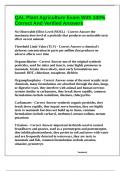QAL Plant Agriculture Exam With 100%
Correct And Verified Answers
No Observable Effect Level (NOEL) - Correct Answer-the
maximum dose level of a pesticide that produces no noticeable toxic
effect on test animals
Threshold Limit Value (TLV) - Correct Answer-a chemical's
airborne concentration in parts per million that produces no
adverse affects over time
Organochlorine - Correct Answer-one of the original synthetic
pesticides, used for mites and insects, some highly poisonous to
mammals, breaks down slowly, most early formulations now
banned: DDT, chlordane, toxaphene, dieldrin
Organophosphates - Correct Answer-some of the most acutely toxic
chemicals, many formulations are absorbed through the skin, lungs,
or digestive tract, they interfere with animal and human nervous
systems similar to carbamates, they break down rapidly, common
formulations include malathion, diazinon, chlorpyrifos
Carbamates - Correct Answer-synthetic organic pesticides, they
break down rapidly, they impair nerve function, they are highly
toxic to mammals but does not build up in tissue, common
formulations include carbaryl, methomyl, metam-sodium, metam-
potassium
Triazines - Correct Answer-important herbicide used to control
broadleaves and grasses, used as a preemergent and postemergent,
they inhibit photosynthesis, they persist in soil and move with water
and are frequently detected in waterways, they are toxic to
mammals and fish, common formulations include atrazine,
simazine, prometryn
iiiiiiiiiiiiiiiiiiiiiiiiiiiiiiiiiiiiiiiiiiiiiiiiiiiiiiiiiiiiiiiiiiiiiiiiiiiiiiiiiiiiiiiiiiiiiiiiiiiiiiiiiiiiiiiiiiiiiiiiiiiiiiiiiiiiiiiiiiiiiiiiiiiiiiiiiiiiiiiiiiiiiiiii Vendarsol
, Neonicotinoids - Correct Answer-insecticide that mimics the efforts
of nicotine, disrupts the central nervous system causing paralysis
and death, less toxic to mammals than organophosphates and
carbamates, harmful to bees
Pyrethroids - Correct Answer-synthetic pesticides, interferes with
sodium transport in nerve cells, they are persistent and found in
waterways, they are often used with synergists, toxic to mammals,
common formulations include bifenthrin, permethrin, cypermethrin
Sulfonylureas - Correct Answer-herbicides used on broadleafs and
grasses, safe for mammels, requires only low application rates,
slightly toxic to fish and invertebrates, resistance has developed to
this family, common formulations include rimsulfuron,
sulfometuron methyl, chlorsulfuron
Strobilurins - Correct Answer-fungicides that disrupts respiration
and metabolism to suppress pathogens, nontoxic to mammals, birds
and bees, highly toxic to fish and aquatic invertebrates, common
formulations include pyraclostrobin, azoxystrobin, trifloxystrobin
Wettable Powders (W or WP) - Correct Answer-forms a milky
suspension when mixed with water, uses higher percentages of
active ingredients, safe for phytotoxicity, the inert carrier is abrasive
which wears out pumps and nozzles, potential hazard of inhaling
dust, requires constant agitation, leaves visible residues
Dry Flowable (DF) or Water_Dispersible Granules (WDG) -
Correct Answer-similar to WP but consists of small granules,
produces less dust making it safer than WP, easy to mix and
measure, requires constant agitation
Soluble Powders (S or SP) - Correct Answer-similar
to WP but completely dissolves in water, requires
iiiiiiiiiiiiiiiiiiiiiiiiiiiiiiiiiiiiiiiiiiiiiiiiiiiiiiiiiiiiiiiiiiiiiiiiiiiiiiiiiiiiiiiiiiiiiiiiiiiiiiiiiiiiiiiiiiiiiiiiiiiiiiiiiiiiiiiiiiiiiiiiiiiiiiiiiiiiiiiiiiiiiiiii Vendarsol




